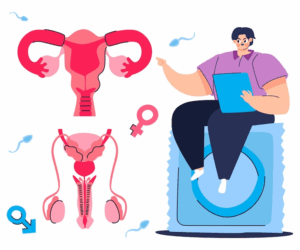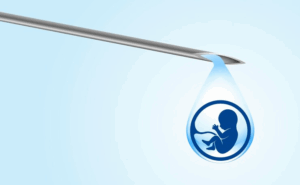Introduction
Male infertility is an issue that affects many couples trying to conceive. Among the various causes of male infertility, non-obstructive azoospermia (NOA) is one of the most concerning. Unlike obstructive azoospermia, where a blockage prevents sperm from being ejaculated, non-obstructive azoospermia occurs when sperm production in the testicles is impaired. This condition is typically more complex to diagnose and treat, making it a challenging hurdle for those seeking fatherhood.
In this article, we will explore the causes of non-obstructive azoospermia, its impact on fertility, and potential treatment options. Whether you’re experiencing infertility or simply want to learn more, this guide will provide helpful insights into this complex condition.
What is Non-Obstructive Azoospermia?
Before delving into the causes, it’s essential to understand what non-obstructive azoospermia (NOA) is. NOA is a form of male infertility where no sperm is found in the semen, despite there being no blockage in the reproductive system. This means that while the sperm transport pathways are clear, the testicles fail to produce sperm. The result is the absence of sperm in the ejaculate, making natural conception impossible without intervention.
The condition can be classified into two types:
- Spermatogenic failure: The inability of the testes to produce sperm due to a problem with sperm formation.
- Sperm maturation arrest: A condition where sperm production starts but fails to mature properly.
NOA can be diagnosed through a semen analysis, blood tests, and, in some cases, a testicular biopsy. If sperm is not detected after multiple tests, doctors will investigate the underlying cause.
Causes of Non-Obstructive Azoospermia
Several factors can contribute to non-obstructive azoospermia. These causes can be genetic, hormonal, environmental, or related to lifestyle choices. Below are the most common causes:
1. Genetic Causes
Genetic factors play a significant role in the development of NOA. Some men may inherit conditions that affect sperm production or function, leading to azoospermia. Here are the key genetic causes:
- Klinefelter Syndrome: This is a genetic disorder where men have an extra X chromosome, leading to reduced testosterone levels and abnormal sperm production. It is one of the most common genetic causes of NOA.
- Y-Chromosome Microdeletions: These deletions involve the loss of small segments of the Y chromosome, which can fail to produce sperm. This condition is usually passed down from father to son.
- Cystic Fibrosis (CF): CF can cause non-obstructive azoospermia due to the absence or blockage of the vas deferens, a tube that carries sperm from the testicles. Even though there may be a genetic predisposition for CF, some men with this condition can still produce sperm but at reduced levels.
- Other Genetic Abnormalities: There are several other genetic conditions, such as chromosomal abnormalities and mutations in sperm production genes, that can lead to NOA.
2. Hormonal Imbalances
Hormones play a crucial role in regulating sperm production in men. Any disruption in the hormonal system can lead to NOA. The key hormones involved in sperm production are:
- Testosterone: Low testosterone levels can impair sperm production. Testicular failure and the inability to produce sufficient testosterone can result in NOA.
- Follicle-stimulating hormone (FSH): FSH is responsible for stimulating sperm production. High levels of FSH often indicate a problem with sperm production in the testes, which can lead to NOA.
- Luteinizing hormone (LH): LH is involved in the regulation of testosterone levels. An imbalance can also lead to fertility issues.
- Prolactin: Elevated prolactin levels can interfere with testosterone production, affecting sperm count and leading to NOA.
Hormonal imbalances can be caused by conditions such as pituitary disorders, obesity, or thyroid problems.
3. Varicocele
A varicocele is an enlargement of veins within the scrotum, which can disrupt the temperature regulation of the testicles. This leads to reduced sperm production and quality. Varicoceles are a common cause of male infertility and can result in NOA if the condition becomes severe enough to affect sperm production in the testicles.
4. Testicular Trauma or Injury
Injuries to the testicles, whether from accidents, sports, or surgical procedures, can lead to NOA. Trauma can damage the seminiferous tubules, which are responsible for producing sperm. This damage can be temporary or permanent, depending on the severity of the injury.
5. Infections and Inflammatory Conditions
Certain infections can damage the reproductive organs and lead to NOA. For example, orchitis (inflammation of the testicles) caused by mumps or other viral infections can lead to a decrease in sperm production. Epididymitis, an inflammation of the epididymis, can also cause problems with sperm maturation.
Chronic inflammatory conditions like autoimmune disorders may also cause the immune system to attack the sperm, leading to NOA.
6. Lifestyle Factors and Environmental Exposure
Environmental and lifestyle factors can have a significant impact on male fertility and sperm production. Some of these include:
- Exposure to toxins and chemicals: Pesticides, heavy metals, and industrial chemicals can harm sperm production.
- Radiation: Exposure to radiation from treatments like chemotherapy or excessive X-rays can damage the testicles, leading to NOA.
- Smoking and alcohol consumption: Both smoking and excessive alcohol intake can negatively affect sperm production.
- Heat exposure: Prolonged exposure to high temperatures, such as from working in hot environments or using hot tubs, can affect sperm production.
7. Obesity
Obesity is another significant factor in the development of NOA. Excess body fat can lead to hormonal imbalances, particularly lower testosterone levels, which can impair sperm production. Additionally, obesity is often associated with other conditions, such as diabetes and hypertension, which can further contribute to fertility issues.
8. Age
While male infertility is often thought to be a woman’s issue, age can also play a role in sperm production. As men age, sperm quality and quantity tend to decrease. Although men can produce sperm throughout their life, the production of healthy, viable sperm decreases with age, which may contribute to NOA in older men.
How is Non-Obstructive Azoospermia Diagnosed?
The diagnosis of NOA typically involves several steps:
- Semen Analysis: A semen sample is tested to check for sperm count, motility, and morphology. If no sperm is present, further tests will be needed.
- Blood Tests: Blood tests to measure hormone levels, including testosterone, FSH, LH, and prolactin, are essential for diagnosing hormonal imbalances.
- Testicular Biopsy: A biopsy involves taking a small tissue sample from the testicle to check for sperm production. This is often done when other tests indicate NOA.
Treatment Options for Non-Obstructive Azoospermia
The treatment options for NOA depend on the underlying cause. In some cases, sperm retrieval can be performed, even if no sperm are found in the semen.Sperm donation
- Hormonal Therapy: If a hormonal imbalance is identified, treatment with hormone replacement therapy may be considered.
- Sperm Retrieval Procedures: Techniques like testicular sperm extraction (TESE) or microdissection TESE can sometimes retrieve viable sperm directly from the testicles, even in cases of NOA.
- Genetic Counseling: For men with genetic causes of NOA, such as Y-chromosome microdeletions, genetic counseling may be recommended to discuss the potential risks of passing the condition to offspring.
Conclusion
Non-obstructive azoospermia is a complex and often emotionally challenging condition for men experiencing infertility. The causes of NOA can range from genetic disorders to lifestyle factors, making diagnosis and treatment crucial in helping affected men achieve fatherhood. If you are dealing with NOA, it’s essential to consult with a fertility specialist who can guide you through your options and help determine the best course of action based on your circumstances.





